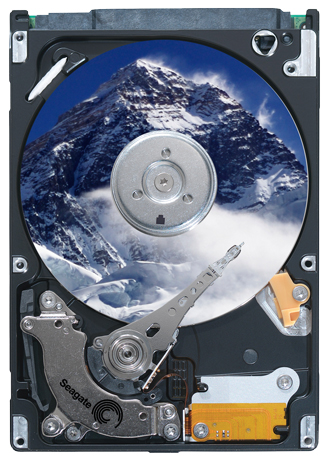
Seagate Ships Hybrid Hard Drive
Seagate ships energy-efficient, fast-responding Momentus® 5400 PSD notebook hard drive; heralds new generation of computer storage for laptops, other computers.

Seagate Technology, the world's number one hard drive maker, launched a new era of digital storage by shipping in volume hybrid notebook disc drives that combine disc storage with flash memory to deliver ultra power efficiency, faster boot-ups and greater reliability for the exploding laptop PC market.
"With instant access to content, an increasingly essential part of the digital lifestyle, laptop users expect systems with snappy response, longer battery life and new levels of durability," said Tom Major , Seagate vice president, Personal Compute Business. "Seagate is delivering in volume worldwide the best of two worlds - hard disc drives and flash memory - to enable laptop PCs with cutting-edge capabilities and tighten the connection between users and their information."
 Seagate has been at the forefront of introducing energy-saving features on
its hard drives, and the new Momentus 5400 PSD hard drive ends
the perennial trade-off for notebook PC makers. Laptop users want faster
systems, but boosting laptop PC performance with higher speed components has
traditionally meant higher power consumption and shorter battery life, raising
the question: How do you reduce power consumption while delivering faster access
to notebook data?
Seagate has been at the forefront of introducing energy-saving features on
its hard drives, and the new Momentus 5400 PSD hard drive ends
the perennial trade-off for notebook PC makers. Laptop users want faster
systems, but boosting laptop PC performance with higher speed components has
traditionally meant higher power consumption and shorter battery life, raising
the question: How do you reduce power consumption while delivering faster access
to notebook data?
Combine power-efficient, quick-response flash memory with a fast hard disc drive.
The new Momentus 5400 PSD (Power Savings Drive) hard drive uses non-volatile cache, or flash memory, to cost-effectively deliver the benefits of solid state disc drives. The Momentus hard drive places commonly used hard drive data onto a large 256MB flash memory to deliver these capabilities:
Faster boot-up
Once a notebook is turned on, a traditional hard drive's platters must spin up before boot-up can begin. Hybrid hard drives load boot-up files on the flash memory to minimize this delay. Once the drive spins up, computer files are pulled simultaneously from the spinning media and the flash.
Lower power consumption
Seagate's Momentus 5400 PSD hard drives reduce hard disc drive power draw by up to 50 percent and extends battery life - especially important in mobile applications - by reducing platter spin time. In hybrid mode, the hard drive's spindle motors spin down, dramatically reducing the drive’s power requirements.
Greater reliability
Reducing platter spin time extends drive life by minimizing wear and tear. In hybrid mode, the drive locks its read-write heads in place, enabling the drive to withstand 900 Gs of shock, the rough equivalent of dropping a laptop from a height of six feet to a hard surface.
Higher performance
Hybrid hard drives also quicken access to laptop data. Windows Vista’s ReadyDrive technology uses Vista Superfetch to analyze computer usage patterns - such as how frequently a worker accesses certain files - and place commonly accessed user data in the flash memory to shorten system response time.
"We're thrilled Seagate is bringing to market hybrid hard drives that take full advantage of Windows Vista," said Dennis Moulton , product manager of Windows Client marketing at Microsoft. "It is this type of innovation in the ecosystem that helps move the bar, and we're excited about the productivity gains this helps bring to our customers in combination with Windows Vista."
All versions of Windows Vista deliver native support for hybrid drives, so system builders and end users alike can take advantage of hybrid hard drive technology today. Hybrid technology also delivers benefits for desktop, enterprise and other hard drives. Look for hybrid technology on other Seagate drive platforms in the future.
Videocast: Seagate Delivers Hybrid Hard Drive To view the videocast on the subject of Seagate’s new hybrid hard drives, please visit http://www.podtech.net/home/3805/seagate-announces-hybrid-drive-for-laptops.
Find Seagate products on ASBIS' B2B Marketplace
Disclaimer:The information contained in each press release posted on this site was factually accurate on the date it was issued. While these press releases and other materials remain on the Company's website, the Company assumes no duty to update the information to reflect subsequent developments. Consequently, readers of the press releases and other materials should not rely upon the information as current or accurate after their issuance dates.
